Effective email marketing is a dynamic process that demands continuous attention. Your focus should shift based on your business’s maturity and focus area. Whether it’s crucial to expand your subscriber list or initiate process automation, your role as a marketer is to identify the platform that aligns best with your present business requirements.
This is where platforms like Privy and Drip come in. They make it easy for you to create engaging emails, personalize and automate them, and more.
That said, both shine in different areas. Drip, for instance, is touted for its robust marketing automation and segmentation capabilities. On the other hand, Privy stands out for its list-building features and clean interface.
The decision between Drip and Privy hinges on your specific needs and budget. It’s crucial to evaluate aspects like user-friendliness, automation capabilities, customer support, and cost before making a choice.
In this Privy vs Drip review, we conduct a thorough comparison of both platforms, taking these factors and others into account.
Let’s get right into it.
Privy vs Drip: Quick overview
Both Drip and Privy are seasoned players in the email marketing landscape and their popularity speaks for themselves.
Drip has garnered an impressive 4.4 rating on the Shopify App Store. Users seem to appreciate the platform’s automation features, as well as how smoothly it functions. However, one drawback is that Drip doesn’t offer a free plan.
Privy too has earned a solid rating of 4.6 out of 5 on the Shopify App Store.
With nearly 25,000 customer reviews, the majority of users have a positive opinion of the platform. Privy’s interface is held in high regard, and many customers also praise its popup forms.
So which tool’s right for you — Drip or Privy?
Before diving into a detailed comparison, let’s take a quick look at their main features.
Just one quick look at the table makes it evident that both tools are pretty distinct. However, a closer examination will help you understand exactly what these differences are.
So, let’s delve into the details.
Privy vs. Drip comparison: Feature by feature
Both Privy and Drip can help you grow your email marketing ROI, but there’s a high chance that one may be better for you.
Also, comparing their features helps you decide if you really need certain functions or if you can cut costs by going without them.
So, let’s begin our Privy vs Drip comparison.
Ease of getting started
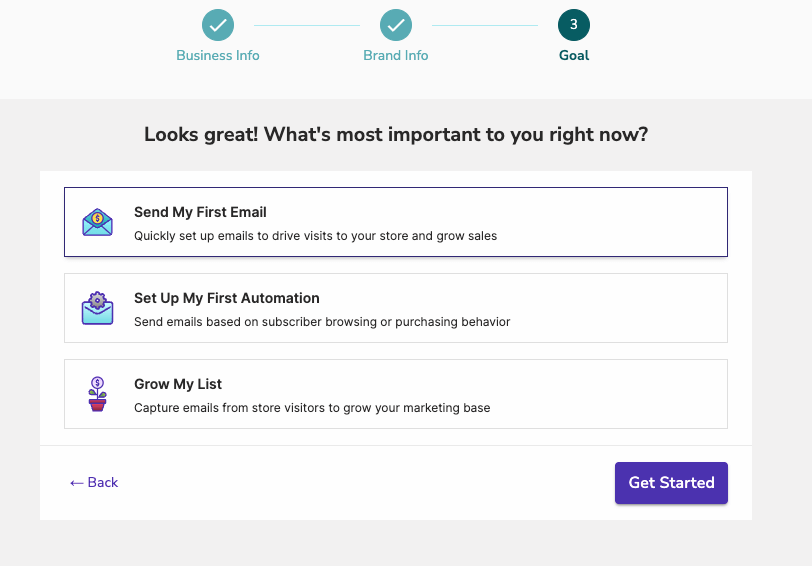
Signing up on both Drip and Privy is pretty straightforward. Whether you’re signing up for Privy’s free plan or Drip’s free trial, no credit card information is required.
To sign up for both platforms, you only have to provide essential details, such as:
- Business name
- Phone number
- Password
Alternatively, if you have a Shopify account, you can use that to sign up on both platforms.
Now, let’s shift our focus to navigation.
On Privy, you’ll find that all your account settings are neatly organized and easily accessible. The interface boasts a modern and visually pleasing design and is free from clutter.
What’s more, the menu structure follows a logical layout, and all the titles and labels are pretty standard. There’s no room for confusion here.
Drip is no different in this regard. It has a user-friendly layout and offers helpful guidance from the moment you create an account.
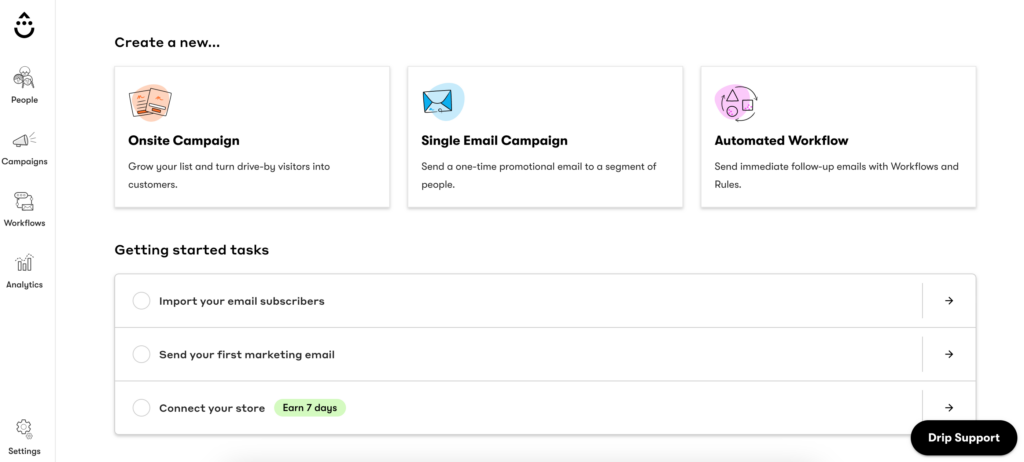
It presents three “getting started” tasks to get users acquainted with the platform. These are accompanied by video tutorials and documentation to ensure a smooth experience.
The main features are also well-structured and categorized, making it easy to navigate through the platform.
It’s a draw. Both Privy and Drip offer a remarkably simple process for newcomers to sign up and begin using their platforms.
Building an email campaign
When it comes to creating email campaigns, there are many distinctions between Privy and Drip.
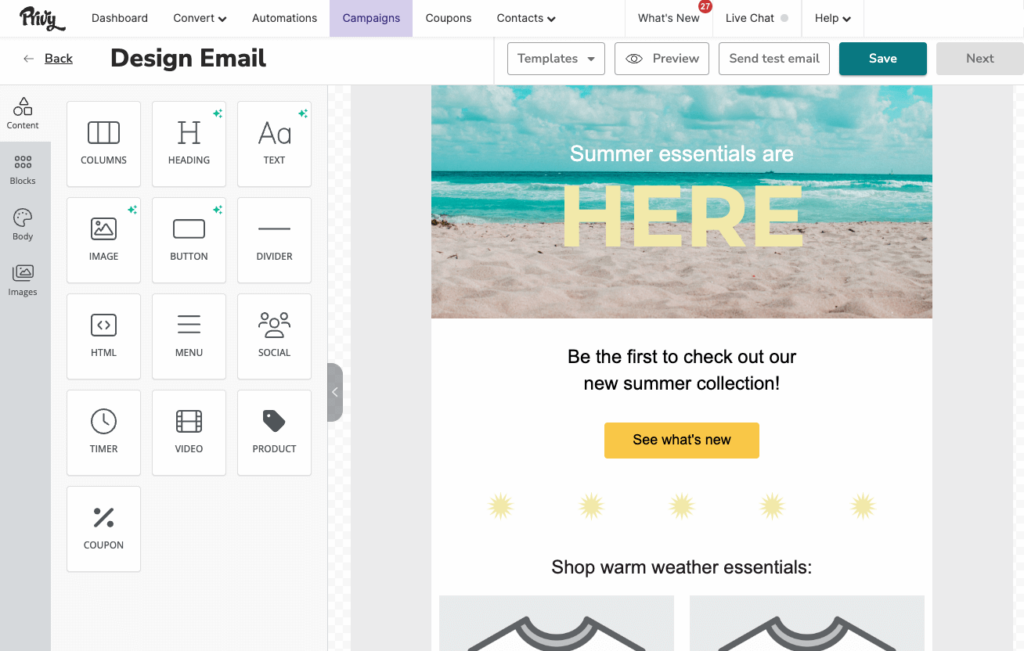
Privy’s email campaign wizard is highly intuitive and offers a clear interface. Moreover, you can easily add your logo, play around with the email structure, and modify various elements as per your liking.
Drip’s email builder doesn’t perform as effectively as many of its competitors. First off, the content blocks aren’t so intuitive and may require some initial familiarization.
It’s also fraught with formatting-related issues. For instance, if you select a one-column email template, you can’t include a two-column element.
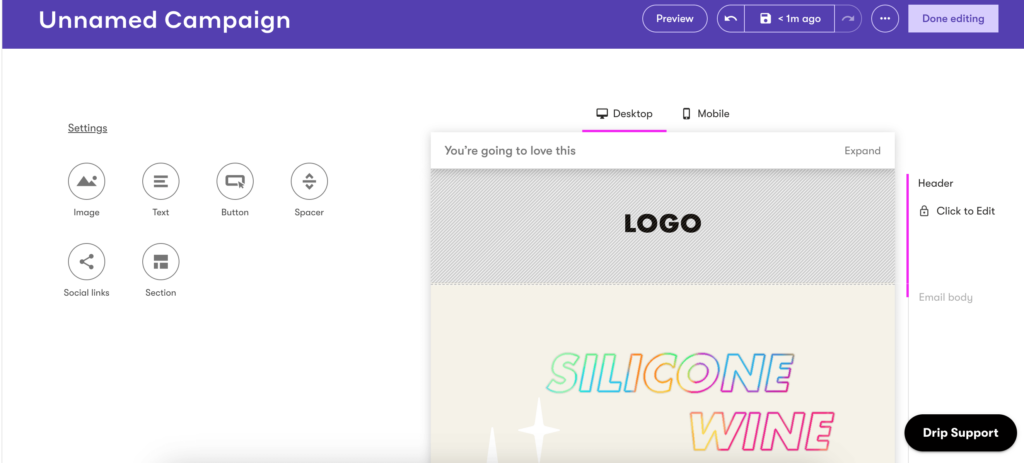
Moreover, fundamental features like personalization, product content blocks, and recommendations are missing in Drip. There are also no surveys and quizzes, which is a bit odd for a tool catering to ecommerce businesses.
In contrast, Privy’s email builder offers several elements for ecommerce businesses. These include:
- Product and coupon features
- AI-generated text elements
- Timers
We found Privy’s coupon feature to be especially valuable. Establishing coupon rules is pretty easy, and you can use these across emails and signup forms repeatedly.
Privy also provides the option to include stock photos in emails, which is a great way to enhance visual appeal.
Sadly, neither of the tools lets you personalize subject lines and preheaders easily. But making these adjustments within the email content is straightforward.
When it’s templates in question, Drip has a slight edge. It offers a collection of 52 modern-looking templates, suitable for a variety of purposes and occasions. Privy provides 20+ templates, which is a good start. However, they’re somewhat limited in variety and are a bit monotonous.
Moreover, Drip supports many types of email campaigns, including A/B tests. Privy is currently missing A/B tests for emails, which is a bit disappointing.
Privy wins this round because its email builder is easier to use and packed with ecommerce features. This makes it the better choice despite Drip’s strengths in certain areas.
Marketing automation
Next, let’s compare Drip vs Privy in their automation capabilities.
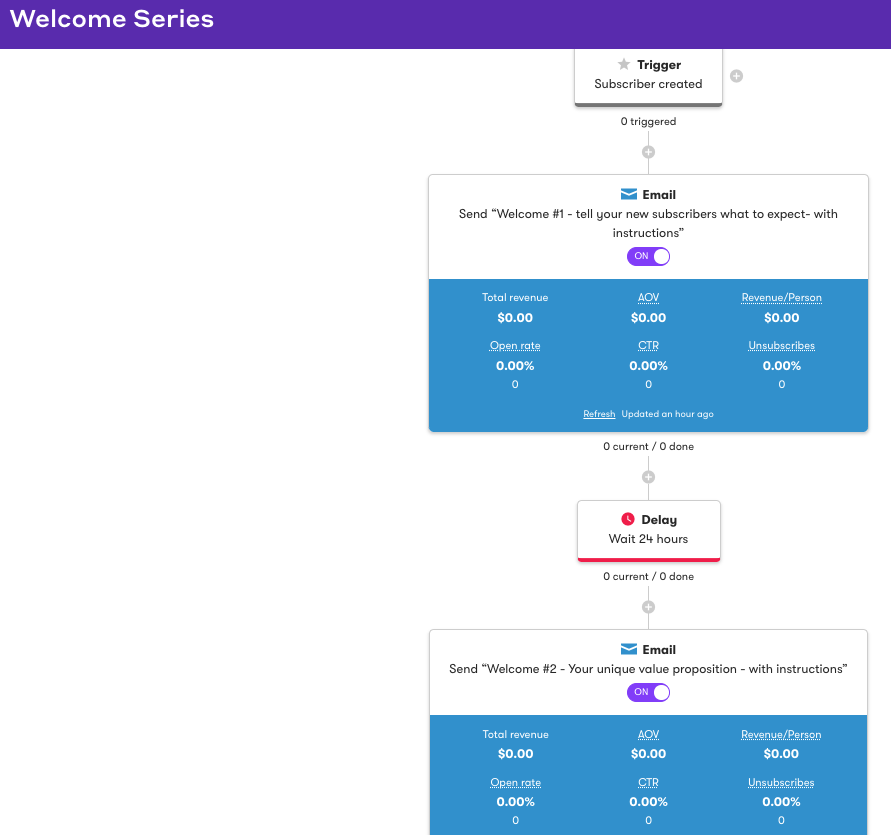
Drip’s automation builder is one of the leaders in the current market. You have the ability to include multiple triggers in a single automation workflow and even integrate triggers from different applications.
You can also include various actions, run parallel processes, and conduct split tests in your workflows.
On the contrary, Privy’s automation features are pretty modest. While they may suit ecommerce beginners, more established businesses will have to look to another tool.

Whether you choose Drip or Privy, you can choose from pre-built workflows designed for specific purposes such as:
- Welcome series
- Cart abandonment
- Customer win-back
- Post-purchase follow-up
However, with Drip, the templates are solely equipped with logic and rules, leaving the email design and content creation up to you.
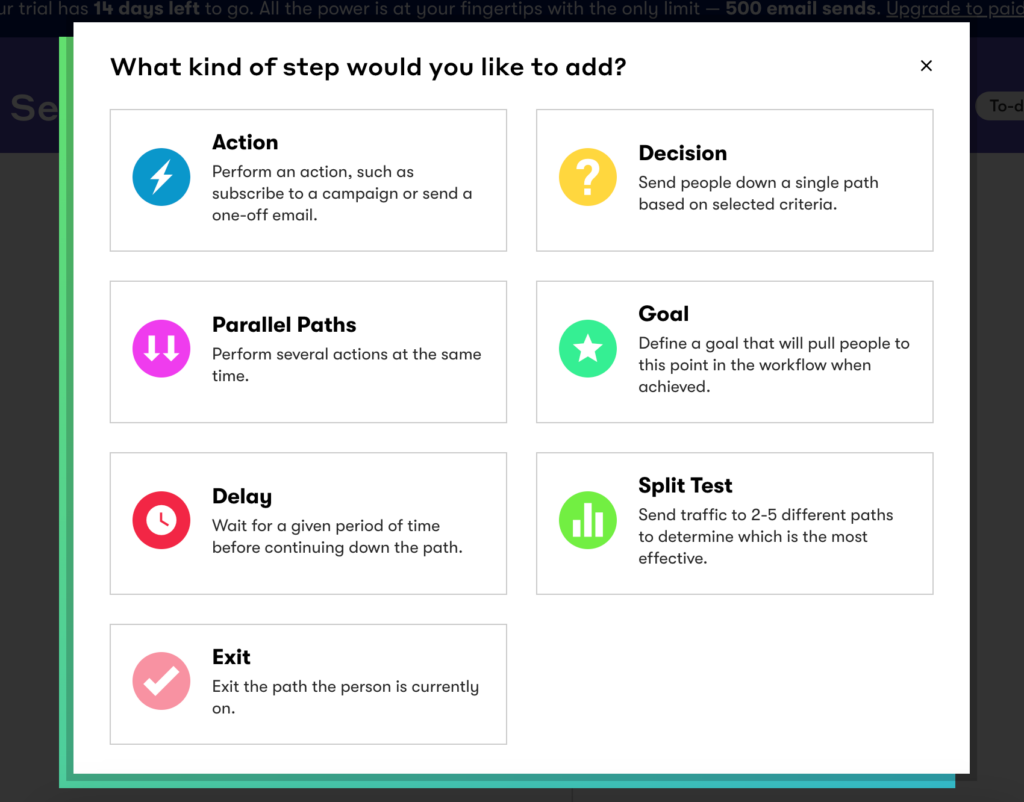
Both tools lack marketing cross-channel integration, but this limitation is more noticeable in Privy. This is because while it lets you choose email or SMS separately, you can’t combine them within a single workflow.
Drip wins here with its advanced, user-friendly automation builder that offers greater flexibility for automating emails.
Signup forms and landing pages
One of the standout features of Privy is its ability to build lists effectively. Let’s examine why that is, along with how Drip competes.
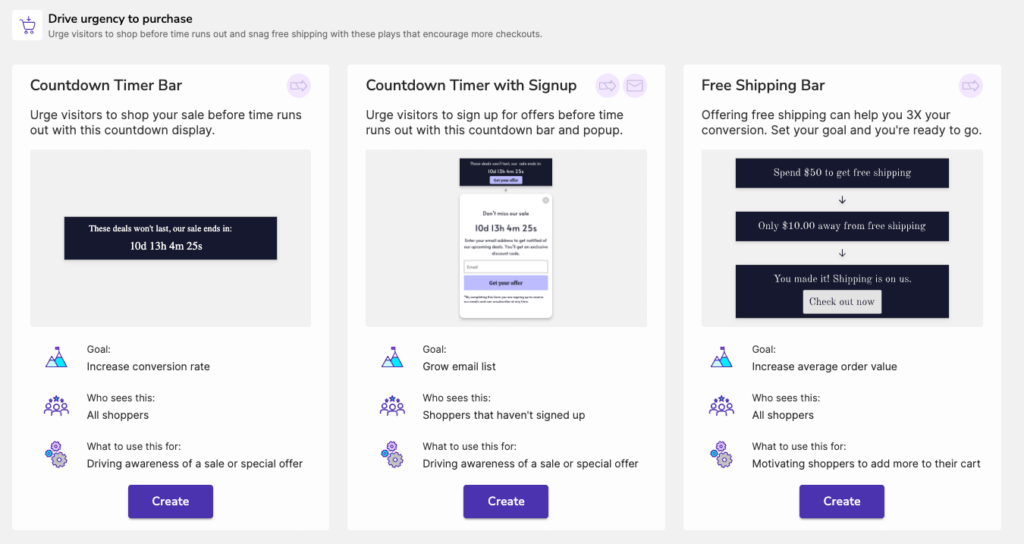
Privy has converted the most successful popups from their customer base into ready-made templates. These proven strategies are easily accessible to all users and are a great way to save time and maximize efficiency.
All of the forms are visually appealing with a variety of modern and attractive designs. Moreover, a gamification element for Spin to Win is available, similar to what Omnisend provides.
Drip offers 30 attractive signup forms that serve various purposes, from data collection to guiding customers to landing pages.
There is ample flexibility in selecting how your forms appear. Here are some display options at your disposal:
- AI-generated automated triggering
- Time-based
- Scroll-percentage trigger
- Exit intent
- Click trigger
- Manual trigger
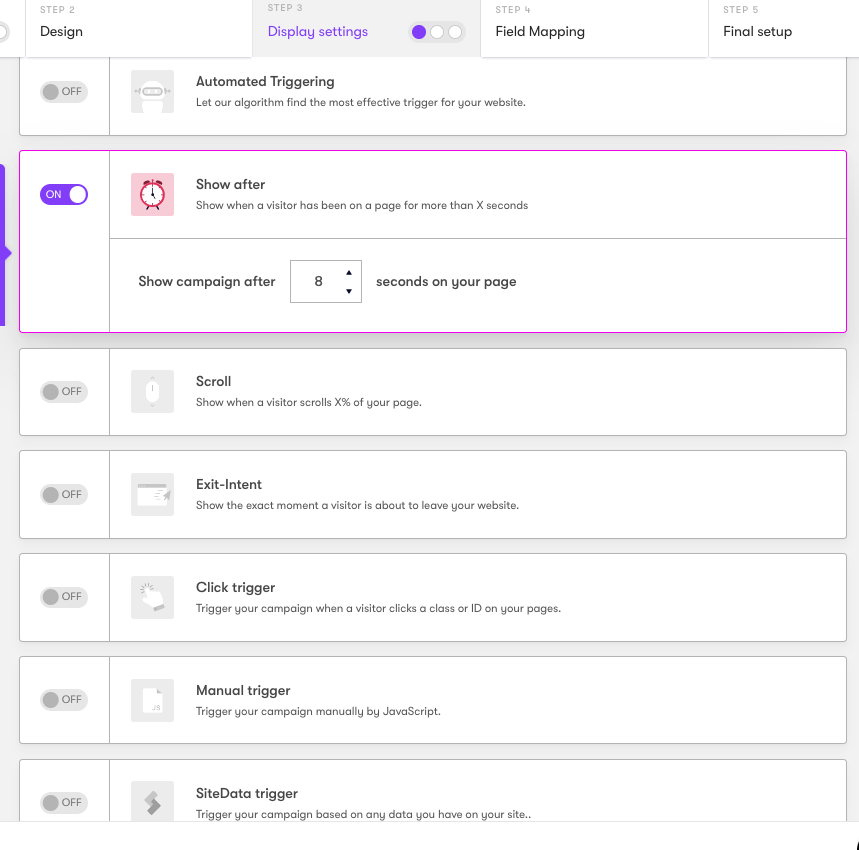 Drip’s SiteData trigger is also pretty unique. It enables personalized campaigns for visitors, considering factors like cart items and value, search queries, browser language, and more.
Drip’s SiteData trigger is also pretty unique. It enables personalized campaigns for visitors, considering factors like cart items and value, search queries, browser language, and more.
Sadly, Drip doesn’t offer landing pages at the moment. Privy does, along with offering 14 landing page templates that are ready to use.
Regarding the popup reporting, both tools allow you to monitor metrics like views, conversion rates, submissions, and more. However, Privy goes beyond by enabling you to compare the performance of signup forms with industry averages.
List management
Drip simplifies the process of importing customer databases, offering a range of options.
You can bring in .csv lists, copy and paste information, individually add contacts, or smoothly switch over from Mailchimp. Additionally, for better organization, you have the ability to assign tags and categorize contacts based on these tags.
Privy’s contact management is just as user-friendly. But they review newly uploaded contacts for security reasons, which can take 1-2 days.
Privy is the obvious winner of this round. Its signup form templates are highly effective, and it distinguishes itself by providing landing pages, a feature entirely absent in Drip.
Segmentation
By segmenting customers based on their journey stage, you can enhance conversion rates.
So, Privy vs Drip, which one performs better in this regard?
On Privy, you can choose from four pre-built segments: Existing customers, actively engaged customers, potential customers, and disengaged contacts.
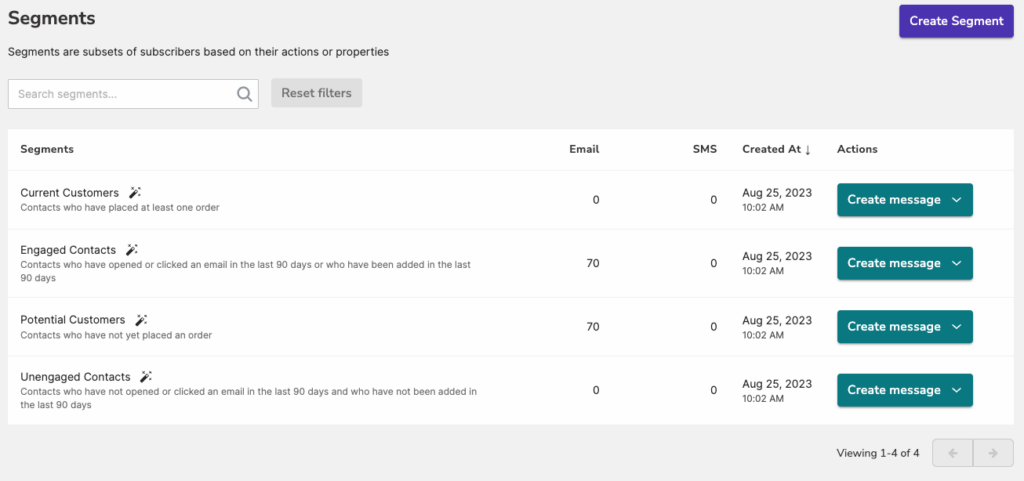
When it comes to Drip, there are a limited number of pre-built audiences available. However, for the most part, the responsibility of building segments falls on your shoulders.
That said, there are several options to segment subscribers. Let’s take a look at some of them:
- Email engagement
- Order history and products
- Review interactions
- Loyalty programs
- Onsite forms
- Individual tags and fields
Similarly, Privy also provides various segment choices. These cover shopping behavior, website interactions, customer characteristics, and email engagement.
This round ends in a draw. Whether you opt for Privy or Drip, you’ll find comparable segmentation capabilities.
Analytics
Privy or Drip: Which platform offers better reporting features?
Drip features a dashboard that delivers comprehensive information about email campaign performance, automation workflow effectiveness, audience engagement, and other aspects.
On Privy, you can monitor metrics such as:
- Opens, clicks, and unsubscribes
- Revenue generated
- Total orders and signups
Moreover, detailed data, such as “Carts Saved,” is accessible for specific types of emails.
Unfortunately, Privy’s analytics are a bit limiting. You won’t find reports on geolocation, device usage, or in-depth ecommerce analytics in this tool.
On the contrary, Drip distinguishes itself with some unique features, including:
- Tailored reports that allow you to choose the metrics you prefer
- Monthly snapshot emails for a quick overview of your campaign performance
Drip takes the lead in this round. It provides a broader spectrum of data along with some unique offerings.
Customer support
A solid customer support team can help you unleash the full potential of the tool. That’s why it’s essential to compare the support quality offered by each tool.
Drip offers email assistance to all paying customers on weekdays, from 9 AM to 5 PM CT. Furthermore, users paying $99/mo or more can also access live chat support during these hours.
Now, let’s talk about Privy.
Prive offers email and live chat support to all paid plan users. However, timings vary by channel:
- Live chat: 10:30 AM to 4:30 PM EST, from Monday to Friday
- Email: 9 AM to 6:30 PM EST, from Monday to Friday
Furthermore, when your email contact list exceeds 9,000, you receive personalized 1:1 support.
However, neither tool provides phone support, assistance on weekends, or support for users on free trials or free plans. Also, some Privy users have raised concerns about the platform’s support on the Shopify App Store, citing issues with responsiveness.
On the positive side, both tools offer a wealth of resources such as blog posts, videos, and more to aid users in finding solutions. Drip goes a step further with live platform walkthroughs on Tuesdays and Thursdays, which is valuable for beginners.
It’s a draw. Both platforms share similar features and limitations in terms of customer support.
Integrations
Robust integrations help businesses adapt to market demands and meet evolving needs.
So, Privy vs Drip, which tool has better integration options?
Drip provides native integrations with well-known ecommerce platforms like Shopify, Bigcommerce, and WooCommerce. Moreover, it offers hundreds of other integrations under categories such as:
- Accounting
- CRM
- Developer tools
- Project management
- Sales
- Support
Additionally, Drip seamlessly integrates with Zapier, connecting to thousands of other applications.
Privy lags behind in this aspect. The list of integrations is quite restricted and includes Shopify, Wix, BigCommerce, Attentive, Postscript, Klaviyo, Mailchimp, and Smile.io. This is way less than what most email marketing tools offer.
Drip emerges as the winner thanks to its wide range of integrations.
Compatibility with other marketing channels
Now, let’s evaluate Drip vs Privy in terms of their compatibility with various marketing channels.
On Privy, you can expand to SMS marketing at an additional cost. However, it doesn’t support social media platforms, Google Ads, and push notifications.
Drip, on the other hand, is only compatible with Facebook Custom Audiences. This integration streamlines audience management on Facebook by automatically updating custom audiences.
In the last round, there is no clear winner as both Privy and Drip perform poorly when it comes to channels beyond email.
Price Comparison
As we conclude this Privy vs Drip comparison, let’s examine the specifics of their free and paid plans.
We’ll evaluate them based on the features they offer, helping you make a cost-effective decision for your business.
Free plans comparison
Drip lacks a free plan but provides a 14-day trial period where you can access nearly all features, with the exception of unlimited emails.
Following the 14-day period, you’ll receive a prompt to upgrade to a paid plan and input your credit card details.
Unlike Drip, Privy does offer a free plan. Here’s what you can expect from it:
- Up to 100 mailable subscribers
- Access to all popup types
- Advanced popup targeting
- Email Service Provider sync
- Shopify coupon integration
Unfortunately, Privy’s free plan lacks essential features like automation, email templates, SMS functions, and customer support. As a result, this plan is primarily suited for basic tasks like building lists and manually creating emails.
Paid plans comparison
Which platform provides a more cost-effective email marketing solution, Privy or Drip?
Drip’s pricing structure is exclusively based on the size of your subscriber list. It only offers one plan, which starts at $39 per month for up to 2,500 subscribers.
On the other hand, Privy offers two pricing plans — Starter and Growth. If your contact count surpasses 1,500, you’ll be switched to the Growth plan automatically. Both Privy plans offer nearly identical features, with the exception of SMS marketing, which is absent from the Starter plan. Therefore, if you have fewer than 1,500 contacts but require SMS capabilities, you’ll still need to subscribe to the higher-tier plan.
Now, let’s take a closer look at the per-month costs for both platforms:
Whether you opt for Privy or Drip, the paid plan includes unlimited email sending capabilities.
However, once your contact list exceeds 30,000 in Drip, the unlimited email feature no longer applies. We found such a low limit to be unusual.
There isn’t a significant gap in pricing between Privy and Drip. Moreover, both tools have strengths and weaknesses in different areas.
For instance, Drip lacks a landing page builder, whereas Privy offers very few third-party integrations. In the end, your decision should be based on the particular features that matter to you.
That being said, both tools are costly compared to competitors like Mailchimp and Omnisend, which provide similar functionality at a lower price.
Privy vs Drip: Which one wins?
Before we reveal the overall winner, let’s recap the features and pricing of Drip and Privy.
3.7
3.8
500 subscribers – $30
1,000 subscribers – $30
5,000 subscribers – $105
10,000 subscribers – $180
50,000 subscribers – $570
100,000 subscribers – $870
500 subscribers – $39
1,000 subscribers – $39
5,000 subscribers – $89
10,000 subscribers – $154
50,000 subscribers – $699
100,000 subscribers – $1199
– Up to 100 contacts
– Access to all popup types
– Advanced popup targeting
– Sync with Email Service Providers
– Sync with Shopify coupons
– Paid plans only
– 14-day trial including all features, and emails to up to 500 recipients
– Extended list of signup forms
– Advanced signup forms functionality
– Intuitive email builder and interface
– Easy to use
– Robust segmentation
– Very advanced marketing automation tools
– Strong segmentation features
– Easy to get started
– Basic automation
– Can’t combine email and SMS in a single workflow
– Incomplete reporting
– Limited customer support
– More expensive than other tools
– Limited email builder
– No landing pages
– Limited customer support
– Ecommerce beginners focused on growing their contact list
– Bloggers
– Ecommerce businesses with established marketing budgets
– Established ecommerce businesses
– Companies with large contact lists
– Freelancers
– Nonprofits
– Small businesses
We would all agree that there isn’t a single email marketing software that suits everyone’s needs perfectly.
When assessing Privy vs Drip, declaring a clear winner is challenging, as both tools come with their own set of pros and cons.
If you prioritize robust automation, advanced ecommerce features, and powerful segmentation, Drip could be a suitable choice. However, note that Drip comes at a relatively high cost, even with its feature set.
Conversely, if your focus is on creating visually appealing emails, signup forms, and landing pages, Privy may be a better option. That said, Privy isn’t particularly strong in areas such as analytics and integrations.
Overall, we discovered that both tools lack the advanced functionalities found in tools like Mailchimp and Omnisend. Additionally, they don’t offer the same level of affordability as MailerLite.
While both Privy and Drip are robust tools, we advise exploring other options before making a final decision.
Read full reviews
Related picks for you
Our team strives to be accurate and unbiased in reviewing email tools. However, we recognize that mistakes can happen, and it’s essential for us to stay up to date. If you come across any errors or things that need to be reviewed again, please let us know.





Leave a Reply